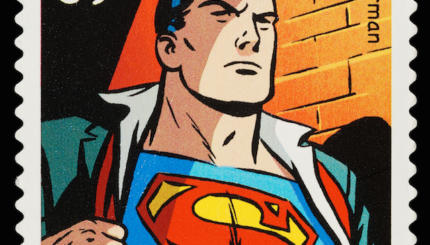I know, I know: ask and ye shall receive. The day after I blogged about the new book From Krakow to Krypton, a new Jewish history of comic books by MAD writer Arie Kaplan, the kind folks at JPS shot us a copy in the mail.
And I have to say, it’s a handsome thing. Despite the blase cover, with its too-boring-to-be-retro font, and “artist! in! action!” shot, which is only slightly more exciting than watching slugs wrestle — it’s a less dynamic version of the cover of Up, Up, and Oy Vey, a book released last year that covers similar territory.
Inside, however, it’s a gorgeous thing. Comics of the past are excerpted generously, from Tales from the Crypt and early Superman and Captain America stories to Sandman and Will Eisner. X-Men writer Chris Claremont’s time on a kibbutz.
The foreword bears special mentioning. It’s written (in comic form) by comic creator Harvey Pekar and illustrated by JT Waldman, is a bit of a fanboy fantasy. Pekar is one of those rare writer/artists who’s become a celebrity, a perpetually-balding, middle-aged Jewish guy whose self-conscious, alternately rough and tender and ironic memoiry stories, collected in his sporadic comic American Splendor (Pekar also starred in the film adaptation), wouldn’t be out of place in the Forward or McSweeney’s. Waldman is the adapter of Megillat Esther, which is probably the first illuminated manuscript Judaism’s produced since the Sarajevo Haggadah — and it’s every bit as beautiful, too.
Okay, and the book itself isn’t half bad, either. Quality and quantity both come prime here. If it’s not an exhaustive history, it’s an exhausting one, as complete as I can imagine any single collection being. It does tend to focus its attention on the early era of comics, where Jewish origins are easiest to find — Siegel & Shuster’s creation of Superman as a metaphor for their alienated Jewish selves; Stan Lee and his collaborators’ ambiguous-but-possibly-Jewish entries like Spider-Man and the X-Men. The section on modern comics, in contrast, seems almost book-report-like in its brevity and reaching for relevance. An entire section on the brief early-00’s series GoGirl seems excessive, considering her near-total obscurity and the fact of her name (Lindsay Goldman) being the most Jewish thing about her, as does the analysis of Neil Gaiman’s heroine, the personification of Death, as a woman, solely because the Kabbalah “depicts” Death as female — that is, since the Aramaic word for “death” is feminine.
All told, though, it’s a handsome book, and one that portrays a great legacy — and does it greatly. It’s the kind of thing that, even if you don’t understand why it’s so awesome, you doubtlessly know a geek who does — and you should introduce them immediately.
Kabbalah
Pronounced: kah-bah-LAH, sometimes kuh-BAHL-uh, Origin: Hebrew, Jewish mysticism.

